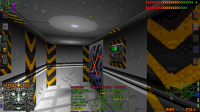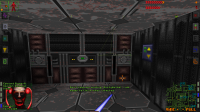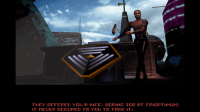System Shock
Playtime: 15 Hours
Finished 03 February 2023.Played the Enhanced Edition port with mouselook, 4K/144Hz resolution support and some additional performance improvements - the overall feel of the port was fantastic; I don't think I could ever truly get used to the DOS version. Played on difficulty 2202 by recommendation - all default except for disabling all challenge in cyberspace, which was a good call. I did do some save scumming, particularly near the very end of the game due to no restoration bays; don't think I abused it too much though, outside the BS rocket car labyrinth on L9. The 15 hour playtime is realtime from the GOG client, which includes some previous playthrough attempts, main menu idling, and savescumming - it's overall more accurate than the 10:48 completion time from the end screen.
While I've long had interest in System Shock 2 due to its close association with Deus Ex as a spiritual predecessor (on top of its own reputation, of course), it wasn't until relatively recently that I've developed an interest in learning more about the original System Shock. Maybe because it's a 1994 game release only 9 months after Doom and I incorrectly assumed this would be a similarly primitive shooter game with barebones worldbuilding, in the same way the original Metal Gear games were to the Metal Gear Solid series. Or perhaps it's because of the extremely unique control scheme, which were strange even when this was released and are still offputting to most people today even after the implementation of mouselook. No matter the case, after finally deciding to give this a shot, those preconceptions were shattered - in contrast to my reserved expectations, I found this game brilliant and very far ahead of its time. The story and world are cohesive, characters are incredibly well realized (especially for how sparse dialogue is) and I feel the technological achievement far outstrips DOOM or any other basic shooter of that era. Part of me even wonders if I'll truly consider System Shock 2 to be better once I give that a proper shot down the line; it'll be an extraordinarily high bar for SS2 to clear.
The plot is very simple in concept; from the very first seconds of the game, it's clear that the primary goal is simply to stop SHODAN and escape Citadel Station. That never changes throughout the entire game, though the means by which you need to do it are constantly escalating as you thwart SHODAN's schemes one by one, leading up to the final encounter. What I like about this is that the tone of the game strikes a delicate balance of power between the Hacker and SHODAN; while the game has you fighting an uphill battle the entire way through, SHODAN is not presented as some comically omniscient being that predicted all your moves and successes months in advance, as so many badly-written games like to do for cheap surprises. There is a sense of desperation from SHODAN as it taunts you throughout the game; as you struggle to take down the laser, jettison Beta Grove, destroy the comms antennas, overload the reactor, and finally approach SHODAN's cyberspace domain on the bridge, SHODAN begins to unravel - relishing their victories against the Flight Deck resistance and disabling your escape pod, while drawing out more and more ramshackle plans in an attempt to at least slow you down. It's a great way of characterizing the irony of SHODAN, which thought it was a God but was stopped by a single man - nowhere near as powerful as it was deluded, and a very big reason why it's instantly a memorable character to me. Visually, this rendition of SHODAN is positively terrifying - it looks like a nightmarish infection, something straight out of H.R. Giger's sketchbook. In contrast to SS2's "woman's face with pulsing green circuitry" look, this game's portrait is far scarier - it's almost difficult to tell where the "face" ends and where the surrounding infection begins. That being said, the squid-carrot look in cyberspace is more goofy than anything so it balances out somewhat.
In addition to the Hacker/SHODAN dynamic, I thought the other side characters introduced through logs and emails added a lot of additional context to the game to make the conflict feel real and haunting, as you explore the remnants of their futile resistance efforts. This game pioneered the presence of audio logs in games, and I found it be one of the best versions I've seen so far. Many other games want to completely ensure that every audio log contains something important to the player - showing them where an item is or hamfisting plot and background explanations - all feel somewhat detached from their own periods of time, as if they are expressly speaking to the player. In this game, however, these are integrated sensibly into the environment; for example, you find logs from resistance members communicating plans and valuable information to each other, or from Bianca Schuler as she prepares to push towards the Bridge to paralyze SHODAN with the isolinear chipset, leaving the log behind to instruct anyone else in the event of her failure. It's a very intricate distinction that I'm having trouble articulating properly at the moment, but it's big enough to make these subplots feel truly alive and not as some random notes from an ancient scholar. A key element is probably that these logs were all recorded in the very recent past of the incident, between people who were all working cohesively together.
For such an old game, the visuals and world design hold up remarkably well. I've already mentioned how some of the character writing helps give a sense of life to the world and a purpose to the actions of the decesased resistance, but the visual themes of each floor on the station are very consistent with their stated function. The hospital floor (L1) contains a number of wards with rooms containing hospital beds, research (L2) has a bunch of offices, the flight deck (L5) has several large open docking bays, etc. The overall organization of Citadel Station generally makes a lot of sense as well, with each serving a function that you would realistically expect on a massive R&D-focused station, which again helps in selling this idea of being stranded in space. It also makes the frequent backtracking in the missions feel meaningful, rather than simply serving as a ploy to avoid designing more areas - it makes sense that you would have to trek through the lower levels of the station when you have to scuttle the reactor later in the game, as an example. A common complaint about the map is its confusing nature, but that is actually explained quite well in this game, and is a really nice extra touch to the worldbuilding. A frequent mention in some audio logs and in some of SHODAN's communications that the cyborgs are being used to rearrange the format of the higher floors. This foreshadows the layouts of the upper floors, especially 7 and above, which stop making sense and become increasingly labyrinthine, like L8's giant tower for no reason. Even in the lower floors 4-6 (as well as the Reactor), there are parts of the map that are strangely designed, or with destroyed doors - early signs of this same thing happening across the rest of the station. Lastly, I really like the fact that the environments in this game are overwhelmingly not dark; the designers knew that this game didn't need to be extremely dim to sell the fear of being stranded in space. This choice really makes the few truly dark areas in the game really stand out - L3 Maintenance is a really creepy area, which I avoided whenever possible (or just sprinted between elevators otherwise).
I like many of the aspects of the game's design, but I won't deny that this is an area where it shows its age as a very early shooter mechanically. Aiming is very hit-or-miss; hitboxes for doorways don't account for smaller openings (like the iris doors) and it's generally pretty easy to cheese enemies by leaning around corners and firing at the first pixel you see of their sprite with hitscan guns. On the other hand, projectile weapons like the Magpulse, Railgun and grenades are almost unusable in tight corridors - not only is the player's movement momentum added to the projectile trajectory (which causes almost all shots fired while strafing to miss), but they will blow up on corners or walls even if the sprite is nowhere close. I imagine there are some major balance shifts due to the updated control scheme; with mouselook support, modules like the rear view which were vital in DOS are completely useless here, and the combat difficulty is probably much easier since aiming is far faster. This probably also explains why I ended up with a ridiculous amount of ammo by the end - based on older forums, it seems like the OG already gave you plenty of ammo, but I ended the game with hundreds or thousands of rounds for each weapon - far more than I would ever need. Other elements of the UI are strange or antiquated in other ways - switching between mouse look and a free cursor to navigate your inventory is something that I've never had to do before, and having to double-press "E" to reload and to pick up or use items was really annoying; I wish those could have been single presses by default instead. On the other hand, customizability of the UI was awesome - the cutomizable panels at the bottom of the screen were super useful and made it possible to toggle between tons of informational displays and inventories.
I wanted to go over this game's automap separately, because it does some things great and others pretty awfully. I really like how the automap doesn't go out of its way to automatically note down anything of any importance, because it forces you to pay a little bit more attention to your surroundings. However, a major problem is that it is almost completely incapable of properly distinguishing between different levels and elevations, which is a bummer because this is one of the very first games to make heavy use of having multiple floors/elevations in a single map with repulsor lifts, ladders, etc. This does make navigation by map more confusing than it needs to be. Additionally, I kind of wish that some more of the important points of interest in a map were automatically labeled - the game is inconsistent with this. Elevators are highlighted and cameras are tracked on the map, yet the energy pylons, surgery beds and restoration bays have no marker whatsoever. However, this is mitigated by the last element of this game's map, which is the inclusion of a very detailed marker/label system, which allows you to tag any location on a map with text, so you can simply add markers for any locations of interest as you explore. The best part is that these markers show up in 3D-space and on the minimap, so you don't even have to open the full map to see the importance of a particular location. I found this feature vital in helping me keep track of door access, dangerous areas, important markers for healing/energy, and general game state (for key objectives); I wish more games would do this, though the simplified & streamlined nature of most modern games wouldn't require anything this in-depth anyway.
Finally, to go over some miscellaneous thoughts on enemies and reoccurring mechanics in this game. Most enemies in this game are fine, but there is a serious lack of feedback when getting hit; the screen will briefly flash red, but for some reason many enemies don't make noise when they shoot at you. Sometimes I would end up dying before I even find them. Also, the invisible mutants on L3 suck. They've got terrible flat hitboxes, fire nearly-unavoidable projectiles that kill you in only a few shots and must be killed specifically with the laser rapier, since they have resistance to other weapons. They're simply awful; it adds the creepy feeling to L3 but also an overwhelming feeling of annoyance, and I'm not sure if that tradeoff is worth it. Speaking of the L3 Maintenance level, the one and only plot-important severed head in the game (Abe Ghiran's) is completely missable, since it's not labeled properly. Not sure if this is a glitch, but it looks the same as any other severed head and is very misleading, since it's the only one that is a key item. Also, a mechanic in this game on all floors of Citadel Station is SHODAN's security level, which you can decrease by destroying cameras and the CPU on each floor. Getting seucrity level to 0% is very arbitrary, since each floor has a massively variant number of cameras and some floors have smaller CPU farms than others. Additionally, the required security level to open some of the SHODAN doors is also wildly inconsistent. In L3, security level must reach exactly 3% (one camera left) before the door is opened, in L7 it's probably ~10%, and in many other floors you have to get all the way down to 0%. Sprinting in this game and any force floors/bridges tend to be awful in this game - the timed force bridges to the Plastique cache in L4 is one of the worst in the game; there's a weird feeling of stickiness, where you can't really go where you want, but it's also slippery, like you're on ice skates or something. Part of this might be due to the port, but I can't imagine it's much better in the original. Last major (?) gripe - on the bridge, the SE labyrinth with the rocket cars is the worst thing I've had to deal with in this game, with infinite kamikaze spawns showcasing the terrible splash hitbox and damage mechs in this game. I felt absolutely no guilt savescumming every step of the way in that area.
There's really only a couple of boss fights in this game, but it might be worth mentioning them. SHODAN is the final boss, but there is no formal encounter in realspace (other than a bunch of dudes in the reactor room), and the cyberspace boss encounter with the squid carrot is as easy as spamming pulsar at it while it slowly moves towards you - it'll pretty much die by the time it can reach you from the opposite side of the room. The actual "realspace" boss is Edward Diego - the guy who coerced the Hacker into unlocking SHODAN for an implant. You fight him up to 3 times - first in L6 to access the master grove jettison switch, then in L5 after destabilizing the reactor core to access the escape pods (optional), and finally at the end of L8 to access the path to the bridge. He's really dangerous for sure, but only if you give him a chance to be. In each case, it's pretty easy to set up a giant explosive trap to instakill him - the game gives you a ton of landmines, nitropacks, and earthshakers which can be used to blow him up instantly every time. Other than Diego, there are 2 Cortex Reavers in the game but those are hilariously easy to kill - since they are so large, they can't even get out the room they start in and you can simply laser rapier them to death for free. All told, the challenge of this game doesn't really come from the bosses at all since they can be cheesed so easily (or pose no real threat to begin with).






